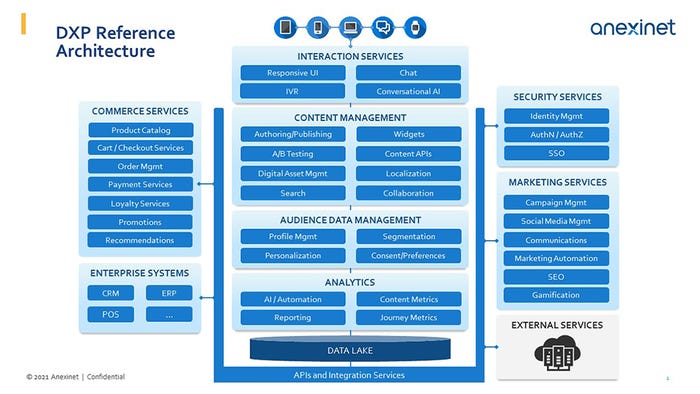Data Integration and the Digital Experience Platform EvolutionData Integration and the Digital Experience Platform Evolution
Data management is key to turning random touch points into a better customer experience.
July 6, 2022

By Brian Atkiss

Brian Atkiss
To stay competitive, organizations need to speak to the customer through content and listen to the data collected throughout the customer’s journey. It’s often a struggle to digitize business operations, deliver connected customer experiences and gather actionable customer insights across multi-experience customer journeys. However, a solution has emerged over the last several years to address this struggle; a solution that isn’t user-interface based but relies on data.
Digital experience platforms (DXPs) are an evolution of content management systems (CMS) and web content management (WCM) systems used to deliver user interfaces for corporate marketing and commerce systems. At the heart of the DXP process is its ability to listen to the data collected throughout the customer’s journey. Data captured through the listening process will ease customer journeys by providing context, personalization and analytics to drive a better experience; but it needs proper management first.
The management and flow of data within a DXP are crucial to its ability to drive the user’s digital journey. When you look closely at the evolution of the various technology solutions from CMS and WCM into complete DX platforms, you’ll see evolutionary commonalities, e.g., the addition of an underlying data management layer within the architecture. From Adobe to Liferay and from Salesforce to Acquia, some aspect of a customer data platform underpins every DPX solution.
Creating a DXP Solution
Before leaping into a DXP creation, IT teams need to understand the standard user profile, where the data resides, how to collect it and how to move it into a DXP data lake. Once this knowledge has been attained, IT can move into the architecture phase, which requires vital components, such as:
Interaction Services: These facilitate the interaction with the user across touch points. These may include web, mobile, chat, voice, etc.
Content Management: This component contains the capabilities to structure and shape user interactions. Using these services, contributors can create, edit, and publish content and integrate it with capabilities (e.g., localization, search, and metadata) — all of which can be accessed via APIs for integration into multiple types of user interactions.
Audience Data Management: This component enables the management of integrated profiles for the digital experience user. The platform can offer segmentation, personalization, and content management across the user journey with this profile.
Analytics: These services allow for automation and reporting across the DXP architecture. Insights into the performance of content throughout the user journey can drive the digital experience for each user.
Data Lake: This repository stores data about user behaviors, transactions, sentiment, etc., as collected by the DXP or from systems outside the architecture.
APIs and Integration Services: These services let components in the DXP architecture interact seamlessly with each other and with other core enterprise systems and external services.

Data As Differentiator
Data is what separates DXPs from standard CMS and WCM solutions. DXPs empower organizations to consolidate and understand user profile data. This rich data lake of knowledge comes from an IT architecture that promotes listening through a targeted digital experience using segmentation, personalization, content targeting and relevant marketing campaigns.
DXP isn’t just a UX project; it’s identifying customer journeys vis-à-vis data and integration. Data distinguishes DXPs from CMS and WCM solutions by turning random and individual user touch points into an orchestrated journey.
Brian Atkiss is director of applied intelligence at Anexinet. He has more than a decade of experience building analytics solutions that generate actionable insights for the Fortune 500 and has an extensive background in social listening and advanced analytics solutions around data integration, machine learning and artificial intelligence. You may follow him on LinkedIn or @anexinet on Twitter.
You May Also Like
